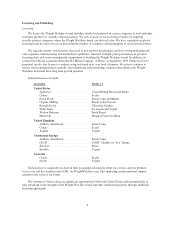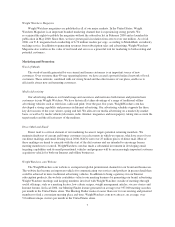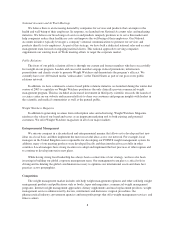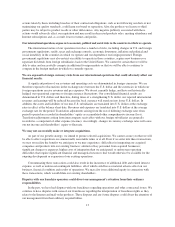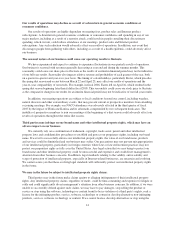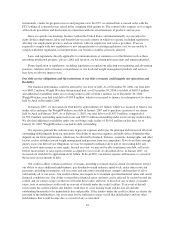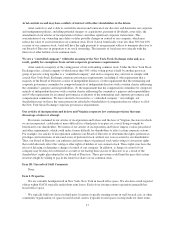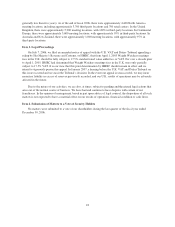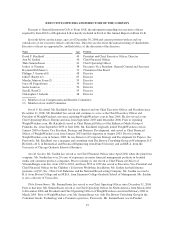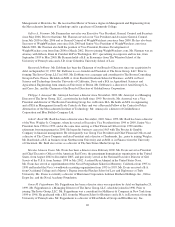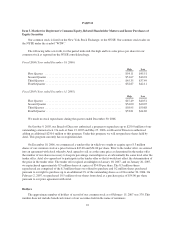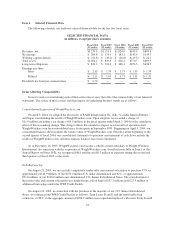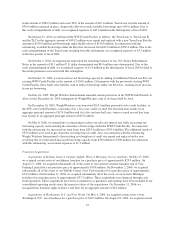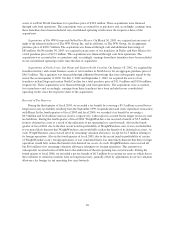WeightWatchers 2006 Annual Report Download - page 29
Download and view the complete annual report
Please find page 29 of the 2006 WeightWatchers annual report below. You can navigate through the pages in the report by either clicking on the pages listed below, or by using the keyword search tool below to find specific information within the annual report.testimonials, claims for program success and program costs. In 1997, we entered into a consent order with the
FTC settling all contested issues raised in the complaint filed against us. The consent order requires us to comply
with certain procedures and disclosures in connection with our advertisements of products and services.
Since we operate our meetings business both in the United States and internationally, we are subject to
many distinct employment, labor and benefits laws in each country in which we operate, including regulations
affecting our employment practices and our relations with our employees and service providers. If we are
required to comply with new regulations or new interpretations of existing regulations, or if we are unable to
comply with these regulations or interpretations, our business could be adversely affected.
Laws and regulations directly applicable to communications or commerce over the Internet such as those
governing intellectual property, privacy, libel and taxation, are becoming more prevalent and remain unsettled.
Future legislation or regulations, including legislation or regulations affecting our marketing and advertising
practices, relations with consumers or franchisees or our food and weight management products and services,
may have an adverse impact on us.
Our debt service obligations and the restrictions of our debt covenants could impede our operations and
flexibility.
Our financial performance could be affected by our level of debt. As of December 30, 2006, our total debt
was $849.2 million. Weight Watchers International had, as of December 30, 2006, total debt of $663.4 million
and additional availability under its revolving credit facility of $184.1 million. As of December 30, 2006,
WeightWatchers.com had total debt of $185.8 million, which was incurred to finance its redemption of its shares
held by Artal in December 2005.
In January 2007, we increased our total debt by approximately $1 billion, which was incurred to finance our
tender offer and repay the WeightWatchers.com debt in January 2007 and to purchase a portion of our shares
held by Artal in February 2007. As of February 2, 2007, our total debt was $1,857.9 million, comprised of
$1,550.0 million outstanding under term loans and $307.9 million outstanding under our revolving credit facility.
We also had additional availability under our revolving credit facility of $190.1 million on this date. As of
January 26, 2007, WeightWatchers.com had no debt outstanding.
We expect to generate the cash necessary to pay our expenses and to pay the principal and interest on all of our
outstanding debt primarily from our operations. Our ability to meet our expenses and debt service obligations thus
depends on our future performance, which may be affected by financial, business, economic, demographic and other
factors, such as attitudes toward weight management and pressure from our competitors. If we do not have enough
money to pay our debt service obligations, we may be required to refinance all or part of our existing debt, sell
assets, borrow more money or raise equity. In such an event, we may not be able to refinance our debt, sell assets,
borrow more money or raise equity on terms acceptable to us or at all. As described above, in January 2007, we
increased our total debt by approximately $1 billion. In fiscal 2007, our interest expense will increase as a result of
the increase in our amount of debt.
Our credit facilities contain customary covenants, including covenants that in certain circumstances restrict
our ability to incur additional indebtedness, pay dividends on and redeem capital stock, make other restricted
payments, including investments, sell our assets and enter into consolidations, mergers and transfers of all or
substantially all of our assets. Our credit facilities also require us to maintain specified financial ratios and satisfy
financial condition tests. Our ability to meet those financial ratios and tests can be affected by events beyond our
control and we cannot assure you that we will meet those ratios and tests. A breach of any of these covenants,
ratios, tests or restrictions could result in an event of default under the credit facilities. If an event of default
exists under the credit facilities, the lenders could elect to cease making loans and declare all amounts
outstanding thereunder to be immediately due and payable. If the lenders under the credit facilities accelerate the
payment of the indebtedness, our assets may not be sufficient to repay in full that indebtedness and our other
indebtedness that would become due as a result of any acceleration.
16


